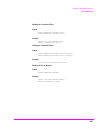
294
S:\agilent\8920\8920b\PRGGUIDE\BOOK\CHAPTERS\advoper.fb
Chapter 5, Advanced Operations
GPIB Service Requests
Setting Up and Enabling SRQ Interrupts
Test Set status information is maintained in eight register groups. Information in
each register group is summarized into a Summary Message. All of the Summary
Messages are, in turn, summarized into the Status Byte Register, either directly to
specific bit positions in the Status Byte Register as shown in
Table 26, or
indirectly through another register group (refer to
“Status Reporting” on page 239
for a detailed discussion of the register groups and status reporting).
Bits in the Status Byte Register can be used to generate a Service Request (SRQ)
message by enabling the associated bit in the Service Request Enable Register.
When an enabled service request condition exists, the Test Set sends the Service
Request message (SRQ) on the GPIB bus and reports that it has requested service
by setting the Request Service (RQS) bit in the Status Byte register to the TRUE,
logic 1, state. When read by a serial poll, the RQS bit is cleared (set to logic 0) so
that the RQS message will be FALSE if the Test Set is polled again before a new
reason for requesting service has occurred.
Table 26 Status Byte Register Bit Assignments
Bit
Position
Binary
Weighting
Assignments
7 128 Operation Status Register Group Summary Message
6 64 Request Service (RQS) message when read by serial poll,
or, Master Summary Status (MSS) message when read by
STB? command
5 32 Standard Event Status Bit (ESB) Summary Message
4 16 Output Queue Message Available (MAV) Summary
Message
3 8 Questionable Data/Signal Register Group Summary
Message
2 4 Unused in Test Set
1 2 Hardware #2 Status Register Group Summary Message
0 1 Hardware #1 Status Register Group Summary Message


















